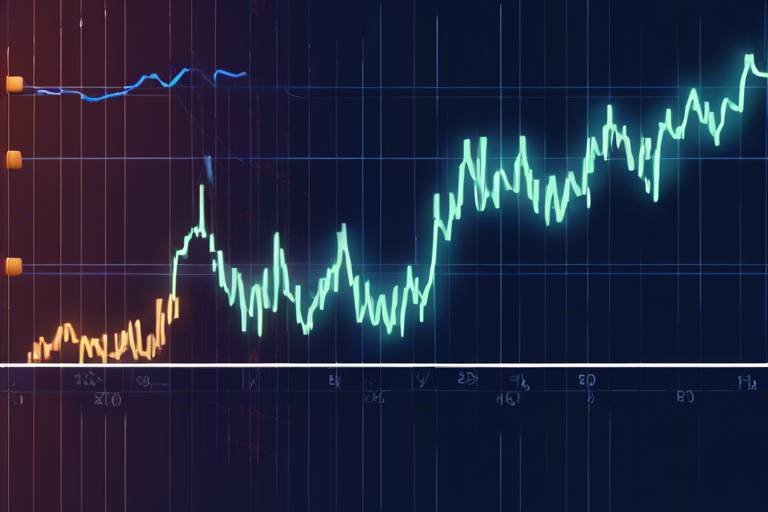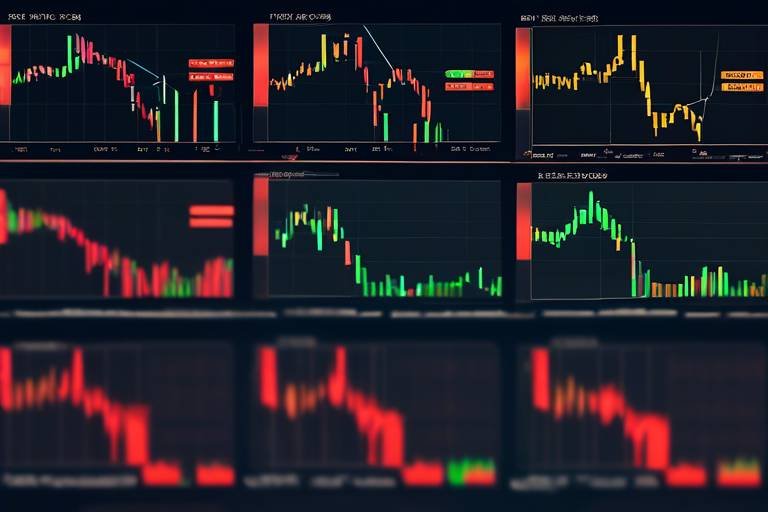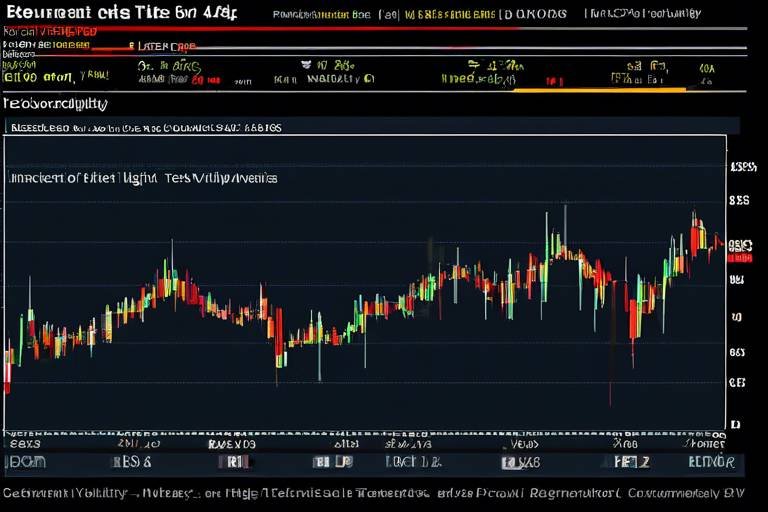How to Identify Market Trends Using Price Channels
In the bustling world of financial markets, understanding how to identify market trends is akin to having a treasure map in a vast ocean. One of the most effective tools in this quest is the concept of price channels. These channels serve as navigational aids, helping traders to decipher the ebb and flow of price movements within defined boundaries. By recognizing these patterns, traders can make informed decisions that enhance their chances of success. But how exactly do price channels work, and why are they so crucial for traders? Let’s dive deeper into this fascinating topic!
Price channels are graphical representations that illustrate the range of price movements over a specific period. They are formed by drawing two parallel lines that encapsulate the price action—one line for resistance (the upper boundary) and one for support (the lower boundary). The significance of price channels lies in their ability to visually communicate market sentiment. When prices consistently bounce between these lines, it indicates a stable trend, making it easier for traders to anticipate future movements. Imagine price channels as the walls of a racetrack; they confine the race cars (prices) to a specific path, allowing traders to predict when they might speed up or slow down.
There are several types of price channels, each with its own unique characteristics and implications for traders. Understanding these types is essential for effective market analysis. The three most common types include:
- Ascending Price Channels: These indicate a bullish trend, characterized by a series of higher highs and higher lows.
- Descending Price Channels: These reflect a bearish trend, showcasing lower highs and lower lows.
- Horizontal Price Channels: These occur when the price moves sideways, indicating a period of consolidation.
Ascending price channels are a trader's best friend in a bullish market. They are identified by drawing parallel lines along the rising highs and lows. This pattern indicates that buyers are in control, pushing prices higher. To effectively utilize ascending channels in trading strategies, traders often look for opportunities to enter long positions when the price approaches the lower boundary. This approach can maximize potential gains while minimizing risks. Think of it as catching a wave at just the right moment—timing is everything!
Conversely, descending price channels signal a bearish trend. These are characterized by declining highs and lows, indicating that sellers dominate the market. Recognizing this pattern allows traders to position themselves for potential short trades, especially when prices hit the upper boundary. Just like a rollercoaster that’s going down, descending channels can create thrilling opportunities for profit if navigated correctly. Traders must remain vigilant, as breakouts from these channels can lead to significant market shifts.
Accurately drawing price channels is crucial for effective market analysis. To create reliable price channels on charts, traders should follow these steps:
- Identify the price extremes (highs and lows) over a specific timeframe.
- Draw a line connecting the highs to form the resistance line.
- Draw another line connecting the lows to form the support line.
- Ensure the lines are parallel and extend them into the future to anticipate price movements.
By following these steps, traders can create a clear visual representation of market trends, allowing for better decision-making.
Support and resistance levels are the backbone of price channels. Identifying these levels is essential for channel trading. Support represents a price level where buying interest is strong enough to overcome selling pressure, while resistance is where selling interest prevails. Traders can identify these levels by examining historical price data and looking for points where the price has reversed direction multiple times. Recognizing these levels helps traders make informed decisions about entry and exit points in their trades.
Integrating technical indicators with price channels can significantly enhance trading strategies. Popular indicators that complement price channel analysis include:
- Moving Averages: These smooth out price data to identify trends more easily.
- Relative Strength Index (RSI): This helps determine whether a market is overbought or oversold.
- MACD (Moving Average Convergence Divergence): This indicates potential buy and sell signals based on moving averages.
By combining price channels with these indicators, traders can gain a more comprehensive view of market dynamics, enabling them to make more informed trading decisions.
Breakouts from price channels can signal potential market reversals or continuations. When prices break above the resistance line, it may indicate a bullish trend, while a break below the support line could signify a bearish trend. Traders must interpret these breakouts carefully, as they often lead to increased volatility. Understanding the implications of breakouts can provide traders with valuable insights into market sentiment and help them adjust their strategies accordingly.
Price channels can be applied in various trading scenarios. For instance, a trader might use an ascending price channel to identify potential entry points for long positions, while utilizing a descending channel to spot short-selling opportunities. Additionally, traders can combine price channels with other technical analysis tools to create robust trading strategies. The versatility of price channels makes them an invaluable tool for traders looking to enhance their decision-making process.
Q: What are price channels?
A: Price channels are graphical representations that show the range of price movements over time, defined by parallel lines indicating support and resistance.
Q: How do I draw price channels?
A: To draw price channels, identify the price extremes, connect the highs for the resistance line, and connect the lows for the support line, ensuring the lines are parallel.
Q: What do breakouts from price channels indicate?
A: Breakouts can signal potential market reversals or continuations, with a break above resistance indicating a bullish trend and a break below support indicating a bearish trend.

Understanding Price Channels
Price channels are essential tools for traders, acting as visual representations of price movements within defined boundaries. Imagine a river flowing between two banks; the price channel serves as those banks, guiding price action and helping traders navigate the turbulent waters of the financial markets. By identifying these channels, traders can gain valuable insights into potential price movements, making informed decisions based on the underlying trends.
At their core, price channels consist of two parallel lines that frame the price action of an asset over a specific period. These lines are formed by connecting the highs and lows of price movements, creating a visual framework that highlights the prevailing trend. The upper line, often referred to as the resistance level, indicates where prices tend to stall or reverse, while the lower line, known as the support level, shows where prices may bounce back after a decline.
Understanding price channels is crucial for effective market analysis, as they help traders identify whether an asset is trending upward, downward, or moving sideways. This knowledge can be the difference between making a profitable trade and incurring losses. For instance, if the price is consistently bouncing between the support and resistance levels of an ascending channel, it signals a bullish trend, suggesting that traders might want to consider buying. Conversely, if prices are falling within a descending channel, it indicates a bearish trend, prompting traders to consider selling or shorting the asset.
Moreover, price channels can also help traders manage risk. By using the support and resistance levels as reference points, traders can set stop-loss orders to protect their investments. For example, if a trader enters a position near the support level of a price channel, they might place a stop-loss order just below this level. This way, if the price breaks through the support, the trader can minimize potential losses.
In summary, understanding price channels is not just about recognizing patterns; it's about leveraging these insights to make strategic trading decisions. By identifying the boundaries of price movements, traders can better anticipate future price action, manage risk, and ultimately enhance their trading performance.

Types of Price Channels
When it comes to navigating the financial markets, understanding the is crucial for any trader looking to make informed decisions. Price channels are not just arbitrary lines drawn on a chart; they are significant indicators that can reveal the underlying trends in market behavior. Essentially, price channels help traders visualize the price movement within specific boundaries, allowing them to anticipate future price actions. There are three primary types of price channels that traders often rely on: ascending channels, descending channels, and horizontal channels. Each type serves a unique purpose and can provide different insights depending on the market conditions.
To kick things off, let’s delve into ascending price channels. These channels are characterized by a series of higher highs and higher lows, indicating a bullish trend. Imagine climbing a staircase; each step represents a new high, while the support line acts as a solid foundation that keeps the price from falling too far. Traders often look for opportunities to buy when the price approaches the lower boundary of the channel, as this is typically where the price has shown resilience in the past. The psychology behind this is simple: if the price has bounced off this level before, it’s likely to do so again, making it an attractive entry point for traders.
On the flip side, we have descending price channels. These are the exact opposite of ascending channels, featuring lower highs and lower lows, which signal a bearish trend. Picture a slide; as you go down, the price continues to lose ground, and traders are often looking to sell or short the asset as it approaches the upper boundary of the channel. The rationale here is that the price has struggled to break above this level in the past, making it a potential point of resistance. Recognizing these patterns can be the difference between a profitable trade and a costly mistake.
Lastly, let’s not forget about horizontal price channels. These channels are unique in that they indicate a period of consolidation, where the price moves sideways within established support and resistance levels. Think of it as a tug-of-war; neither the bulls nor the bears have the upper hand, and the price fluctuates between two horizontal lines. Traders can take advantage of these channels by buying near the support level and selling near the resistance level, capitalizing on the predictable price movements. The key here is to remain patient and wait for a breakout, which could signal the start of a new trend.
In summary, understanding the different types of price channels—ascending, descending, and horizontal—can significantly enhance your trading strategy. By recognizing these patterns, traders can make more informed decisions and better anticipate market movements. Whether you’re looking to ride the wave of a bullish trend or navigate the choppy waters of a bearish market, price channels provide a valuable framework for analyzing price action.

Ascending Price Channels
When it comes to trading, understanding the dynamics of an ascending price channel can be a game changer. Picture this: a roller coaster that keeps climbing higher and higher, where each peak and valley represents price movements in the market. An ascending price channel is characterized by a series of higher highs and higher lows, indicating a bullish trend. This means that, generally, buyers are in control, pushing prices upward over time. Traders often look for these channels as they can provide valuable insights into potential entry and exit points for trades.
Identifying an ascending price channel involves drawing two parallel lines on a price chart. The upper line connects the peaks, while the lower line connects the troughs. This creates a visual representation of the price movements, allowing traders to see the boundaries within which the price fluctuates. The key here is to ensure that the lines are drawn accurately, capturing at least two significant highs and two significant lows. This not only helps in visualizing the trend but also serves as a guide for potential breakout points.
One of the most exciting aspects of trading within an ascending price channel is the potential for profit. Traders often employ strategies such as buying near the lower boundary of the channel and selling near the upper boundary. However, it's crucial to stay vigilant. If the price breaks below the lower boundary, it could indicate a reversal, prompting traders to reconsider their positions. Conversely, if the price breaks above the upper boundary, it may signal a continuation of the bullish trend, presenting new opportunities for profit.
Moreover, ascending price channels can be enhanced by incorporating other technical indicators. For instance, the Relative Strength Index (RSI) or moving averages can provide additional confirmation of the trend's strength. By combining these tools, traders can make more informed decisions. Imagine you're a detective piecing together clues; the more evidence you have, the clearer the picture becomes.
In summary, ascending price channels are powerful tools for traders looking to capitalize on bullish market movements. By identifying these channels and understanding their implications, traders can navigate the complexities of the market with greater confidence. Remember, while the potential for profit is enticing, effective risk management remains key. Always be prepared for the unexpected twists and turns that the market can throw your way!
- What is an ascending price channel? An ascending price channel is a technical analysis tool that consists of two parallel lines, indicating a bullish trend characterized by higher highs and higher lows.
- How do I identify an ascending price channel? To identify an ascending price channel, draw two parallel lines on a price chart that connect at least two significant highs and two significant lows.
- What trading strategies can I use with ascending price channels? Traders typically buy near the lower boundary and sell near the upper boundary of the channel. It's also wise to use additional indicators for confirmation.
- What should I do if the price breaks below the channel? A break below the channel may indicate a potential reversal. It's essential to reassess your position and consider exiting or adjusting your strategy.

Descending Price Channels
Descending price channels are a fascinating aspect of market analysis that traders often rely on to make informed decisions. These channels represent a bearish trend, where the price consistently makes lower highs and lower lows, creating a downward sloping channel. Imagine a roller coaster that continuously descends; that’s the essence of a descending price channel. It’s a visual representation of a market that’s losing momentum, and understanding this can be crucial for any trader looking to navigate the turbulent waters of financial markets.
To effectively identify descending price channels, traders look for two key trend lines: the upper trend line, which connects the lower highs, and the lower trend line, which connects the lower lows. When these lines converge, they form a channel that can provide valuable insights into potential price movements. If you visualize this, it’s like framing a picture; the lines create a boundary that helps you see the overall trend more clearly. As prices bounce between these lines, traders can identify opportunities to enter or exit trades, maximizing their potential profits.
Recognizing a descending price channel is not just about spotting the lines; it also involves understanding the market psychology behind it. When traders see prices consistently declining, it can create a sense of fear and uncertainty, leading to further selling pressure. This is where the concept of support and resistance becomes vital. The lower trend line often acts as a support level, where buyers may step in and attempt to halt the decline. Conversely, the upper trend line can serve as a resistance level, where sellers might emerge to push prices lower. It’s this interplay between buyers and sellers that creates the dynamic movement within the channel.
Moreover, traders should be aware of the potential for breakouts from descending channels. A breakout occurs when the price moves outside the established channel boundaries, which can signal a shift in market sentiment. For instance, if the price breaks above the upper trend line, it may indicate a reversal in trend, suggesting that the bearish sentiment is weakening. Conversely, a breakout below the lower trend line could confirm the continuation of the bearish trend. This is why monitoring these channels is essential for traders looking to capitalize on market movements.
In summary, descending price channels are a powerful tool for traders who wish to understand the underlying market trends. By recognizing the structure of these channels and the psychological factors at play, traders can make more informed decisions. Whether you are a seasoned trader or just starting, mastering the art of identifying and analyzing descending price channels can significantly enhance your trading strategy.
- What is a descending price channel? A descending price channel is a chart pattern that indicates a bearish trend, characterized by lower highs and lower lows.
- How do I identify a descending price channel? To identify a descending price channel, draw trend lines connecting the lower highs and lower lows on a price chart.
- What does a breakout from a descending price channel indicate? A breakout from a descending price channel can signal a potential reversal or continuation of the trend, depending on the direction of the breakout.
- Can descending price channels be used in any market? Yes, descending price channels can be applied in various markets, including stocks, forex, and commodities.

Drawing Price Channels
When it comes to analyzing market trends, accurately is a skill that can set you apart from the average trader. Think of price channels as the framework of a house; without a solid structure, everything else can come crashing down. Price channels help you visualize the boundaries of price movements, allowing you to make informed decisions based on where the market is likely to head next. But how do you draw these channels effectively? Let’s break it down.
First, you need to identify the highs and lows of the price action. Start by looking at a price chart—this could be a daily, weekly, or even hourly chart, depending on your trading style. Look for at least two significant high points and two significant low points that form the basis of your channel. Connecting these points with straight lines will give you the upper and lower boundaries of your price channel. It’s like connecting the dots in a puzzle; the clearer the connections, the more complete the picture.
Next, it’s essential to ensure that your lines are parallel. This means that the distance between your upper and lower lines should remain consistent throughout the channel. If they start to diverge, it might indicate a shift in market sentiment. A good rule of thumb is to use the trendline tool available in most charting software. This tool allows you to draw straight lines that can help you visualize the price channel more accurately.
Another crucial aspect is the time frame you choose for your analysis. Different time frames can yield different results. For instance, a price channel drawn on a daily chart may look entirely different than one drawn on a 15-minute chart. The key here is consistency; choose a time frame that aligns with your trading strategy and stick to it. Most traders find that a combination of time frames can provide a more comprehensive view of market trends.
Additionally, it’s important to incorporate support and resistance levels when drawing your channels. These levels act as psychological barriers for traders. When price approaches these levels, it can either bounce back or break through, leading to a potential trend reversal. By identifying these levels, you can refine your price channels further. Consider marking these levels on your chart with horizontal lines, as they will provide context to your channel analysis.
Lastly, remember that drawing price channels isn’t an exact science. It requires a bit of artistry and intuition. You may need to adjust your channels as new price data comes in. This flexibility can be the difference between a successful trade and a missed opportunity. So, don’t be afraid to tweak your channels as you gather more information. After all, the market is constantly evolving, and your analysis should reflect that.
In summary, drawing price channels involves a combination of identifying significant highs and lows, ensuring parallel lines, choosing the right time frame, incorporating support and resistance levels, and maintaining flexibility. Mastering this skill can provide you with a clearer understanding of market trends, ultimately leading to more informed trading decisions.
- What are price channels? Price channels are graphical representations of price movements within defined upper and lower boundaries, helping traders identify trends.
- How do I draw a price channel? Identify significant highs and lows on your chart, connect them with parallel lines, and incorporate support and resistance levels for more accuracy.
- What time frame should I use for drawing price channels? The time frame depends on your trading style; consistency is key, so choose one that aligns with your strategy.
- Can price channels change? Yes, price channels can evolve as new price data comes in, so be prepared to adjust your channels accordingly.

Identifying Support and Resistance
Identifying support and resistance levels is a fundamental skill for any trader looking to navigate the complexities of the financial markets. These levels act as psychological barriers where price movements tend to stall or reverse, making them essential for effective trading strategies. Think of support as a safety net that prevents prices from falling below a certain point, while resistance serves as a ceiling that prices struggle to break through. Understanding these concepts can significantly enhance your market analysis and decision-making process.
To identify support and resistance levels, traders often rely on historical price data. By examining past price movements, you can pinpoint areas where the price has previously bounced off or stalled. For instance, if a stock has repeatedly bounced back after hitting $50, that level becomes a significant support point. Conversely, if the price consistently fails to break above $70, this creates a resistance level. By marking these levels on your charts, you can visualize potential entry and exit points for your trades.
Additionally, it’s crucial to consider the time frame you’re analyzing. Support and resistance can vary significantly across different time frames. A level that appears strong on a daily chart may not hold the same weight on a weekly chart. Therefore, it's wise to analyze multiple time frames to gain a more comprehensive understanding of these levels. For example, a trader might spot a resistance level on a daily chart but find that it aligns with a support level on a weekly chart, indicating a stronger market sentiment.
Moreover, the strength of support and resistance levels can also be gauged by the number of times the price has interacted with these levels. The more times a price level has been tested without breaking, the stronger the support or resistance becomes. This can be visualized in a simple table:
| Interaction | Level Type | Strength |
|---|---|---|
| 1-2 times | Weak | Low confidence |
| 3-5 times | Moderate | Medium confidence |
| 6+ times | Strong | High confidence |
In addition to historical price levels, traders often use other tools to confirm support and resistance. These include moving averages, trend lines, and Fibonacci retracement levels. For example, a trader might notice that a moving average aligns closely with a previously identified support level, reinforcing their confidence in that level's strength. Similarly, Fibonacci retracement levels can provide additional insights into potential reversal points, allowing traders to make more informed decisions.
Lastly, it's essential to stay vigilant and adapt to changing market conditions. Support and resistance levels are not static; they can shift due to new market information or changes in trader sentiment. Therefore, regularly reassessing these levels can help you stay ahead of the curve and refine your trading strategies accordingly. By mastering the art of identifying support and resistance, you empower yourself to make more strategic trades and navigate the market with greater confidence.
- What are support and resistance levels? Support levels are price points where a stock tends to stop falling and often bounces back, while resistance levels are where prices tend to stop rising.
- How do I identify these levels? You can identify support and resistance by analyzing historical price data and observing where prices have previously reversed.
- Why are these levels important? They help traders determine entry and exit points, manage risk, and make informed trading decisions.
- Can support and resistance levels change? Yes, they can shift due to new market information or changes in trader sentiment, so it's essential to reassess them regularly.

Using Technical Indicators
When it comes to trading, relying solely on price channels can sometimes feel like trying to navigate a ship without a compass. This is where technical indicators come into play, acting as your navigational tools that help you make sense of the turbulent waters of financial markets. By integrating these indicators with price channels, you can enhance your trading strategies and make more informed decisions.
Technical indicators are mathematical calculations based on the price, volume, or open interest of a security. They can help you identify trends, momentum, volatility, and market strength. Here are a few popular technical indicators that work well with price channels:
- Moving Averages: These indicators smooth out price data to identify the direction of the trend. By overlaying moving averages on your price channel, you can see if the price is trending upwards or downwards, providing clarity on potential buy or sell signals.
- Relative Strength Index (RSI): This momentum oscillator measures the speed and change of price movements. An RSI value above 70 typically indicates that a security is overbought, while a value below 30 suggests it is oversold. When combined with price channels, RSI can help confirm breakouts or reversals.
- Bollinger Bands: These bands consist of a middle band (the moving average) and two outer bands that represent volatility. When prices approach the upper band, it may signal that the asset is overbought, while a move towards the lower band may indicate oversold conditions. Using Bollinger Bands alongside price channels can provide additional context for potential trading opportunities.
Using these indicators effectively requires understanding their signals in relation to price channels. For instance, if the price breaks out of an ascending price channel and the RSI is above 70, it might indicate a strong bullish sentiment, but caution is warranted as the asset could be overbought. Conversely, if a price breaks down from a descending channel while the RSI is below 30, it could signal a potential buying opportunity as the asset may be oversold.
It’s also essential to remember that no single indicator is foolproof. The market is influenced by a myriad of factors, and relying on just one tool can lead to misinterpretations. Therefore, combining multiple indicators with price channels provides a more comprehensive view of the market, enabling you to make better-informed trading decisions.
In conclusion, integrating technical indicators with price channels is like adding a GPS to your trading journey. It enhances your ability to navigate through market fluctuations and helps you identify potential entry and exit points. As you become more familiar with these tools, you'll find that they complement each other beautifully, leading to a more robust trading strategy.
1. What are price channels?
Price channels are graphical representations that show the upper and lower boundaries of price movements over a specific period, helping traders identify trends.
2. How can technical indicators improve my trading strategy?
Technical indicators provide additional insights into market conditions, helping traders confirm trends, identify reversals, and make informed decisions when used alongside price channels.
3. Can I rely solely on price channels for trading?
While price channels are valuable tools, relying solely on them may not provide a complete picture. It's advisable to use them in conjunction with other technical indicators for better accuracy.
4. What is the best technical indicator to use with price channels?
There isn't a one-size-fits-all answer, as the best indicator often depends on your trading style. However, moving averages and RSI are commonly used and can be quite effective when combined with price channels.

Interpreting Price Channel Breakouts
When it comes to trading, understanding price channel breakouts can be a game changer. Imagine you're on a roller coaster, and you can see the peak ahead. That peak represents a breakout point, where the thrill of the ride intensifies. Similarly, in the financial markets, a breakout from a price channel can signal a significant shift in market momentum. Traders need to be alert during these moments, as they often indicate potential reversals or continuations of existing trends.
So, how do you interpret these breakouts? First, it’s essential to recognize that not all breakouts are created equal. Some might fizzle out like a soda left open too long, while others can lead to explosive moves in price. A breakout occurs when the price moves outside the established boundaries of a price channel, either above the upper line or below the lower line. This movement can suggest that the market is ready to change direction or continue in the same trend, depending on the context.
To effectively interpret breakouts, traders should consider the following factors:
- Volume: A breakout accompanied by high trading volume is generally more reliable. It indicates strong interest and commitment from traders, suggesting that the breakout is genuine.
- Market Context: Always analyze the broader market conditions. Are there any significant news events or economic indicators that could influence the price movement? Understanding the context can help you make more informed decisions.
- Retests: After a breakout, the price may return to test the breakout level. This retest can provide a second chance to enter a trade if the price holds above or below the channel line.
Now, let’s dive deeper into the implications of breakout types. A bullish breakout, where the price moves above the upper channel line, often signals that buyers are gaining control. This can be an excellent opportunity for traders looking to enter long positions. Conversely, a bearish breakout below the lower channel line suggests that sellers are taking charge, which might prompt traders to consider short positions.
It’s also important to note that false breakouts can occur. These are like mirages in the desert—appearing promising at first but ultimately leading to disappointment. To avoid falling into this trap, traders should always have a plan in place. Setting stop-loss orders just outside the channel can help mitigate losses in case the breakout turns out to be false.
In summary, interpreting price channel breakouts requires a keen eye and a strategic approach. By paying attention to volume, market context, and potential retests, traders can better position themselves to capitalize on these pivotal moments in the market. Remember, every breakout is an opportunity, but it’s essential to tread carefully and make well-informed decisions.
What is a price channel?
A price channel is a technical analysis tool that consists of two trendlines that define the upper and lower boundaries of price movement. It helps traders identify potential support and resistance levels.
How do I identify a breakout?
A breakout is identified when the price moves outside the established channel boundaries, either above the upper line or below the lower line, often accompanied by increased trading volume.
What should I do after a breakout occurs?
After a breakout, consider entering a position in the direction of the breakout. Additionally, watch for a retest of the breakout level to confirm the strength of the move.
Are all breakouts reliable?
No, not all breakouts are reliable. It's crucial to analyze volume, market context, and other indicators to determine the likelihood of a successful breakout.

Practical Applications of Price Channels
Price channels are not just theoretical concepts; they have real-world applications that can significantly enhance trading strategies. Understanding how to effectively implement price channels can lead to better decision-making and improved trading outcomes. Imagine you're navigating through a dense forest; price channels act as your compass, guiding you through the ups and downs of market movements.
One of the most practical applications of price channels is in identifying potential entry and exit points in trades. For instance, when prices approach the upper boundary of an ascending price channel, it may indicate a good opportunity to sell, while a bounce off the lower boundary could suggest a buying opportunity. This approach helps traders capitalize on the natural ebb and flow of the market.
Additionally, price channels can be used in conjunction with other trading strategies. For example, traders might combine price channels with moving averages or momentum indicators to confirm signals. By doing so, they can filter out false breakouts and enhance the reliability of their trades. The synergy between these tools can create a more robust trading strategy, allowing for better risk management and profit potential.
Furthermore, price channels can also serve as a visual representation of market sentiment. A widening channel might indicate increasing volatility and uncertainty, while a narrowing channel could suggest that the market is consolidating and preparing for a breakout. By observing these patterns, traders can gauge the overall market mood and adjust their strategies accordingly.
Another key application is in setting stop-loss and take-profit levels. Traders can utilize the boundaries of price channels to determine where to place their stop-loss orders. For instance, placing a stop-loss just outside the channel can help protect against unexpected market moves while still allowing for potential gains within the channel. This strategic positioning can minimize losses while maximizing the potential for profit.
To illustrate these concepts, consider the following example:
| Scenario | Action | Reason |
|---|---|---|
| Price hits upper channel | Sell | Potential reversal or pullback |
| Price bounces off lower channel | Buy | Support level indicated |
| Channel widens | Monitor closely | Increased volatility |
| Channel narrows | Prepare for breakout | Consolidation phase |
In summary, the practical applications of price channels are vast and varied. They can help traders make informed decisions, set strategic entry and exit points, and manage risk effectively. By integrating price channels into their trading toolkit, traders can enhance their market analysis and improve their overall performance.
- What are price channels? Price channels are technical analysis tools that help traders identify the boundaries of price movements, indicating potential support and resistance levels.
- How do I draw price channels? To draw price channels, identify at least two highs and two lows on a price chart and connect them with trendlines to form the channel boundaries.
- Can price channels predict market direction? While price channels can indicate potential price movements, they should be used in conjunction with other indicators for more reliable predictions.
Frequently Asked Questions
- What are price channels?
Price channels are graphical representations that help traders visualize price movements within defined boundaries. They consist of two parallel lines that indicate support and resistance levels, allowing traders to identify trends and make informed decisions.
- How do I identify an ascending price channel?
An ascending price channel is identified by drawing two parallel lines that connect a series of rising highs and rising lows. This pattern indicates a bullish trend, suggesting that prices are likely to continue rising. Traders can look for opportunities to buy when prices pull back to the lower boundary of the channel.
- What does a descending price channel signify?
A descending price channel indicates a bearish trend, characterized by declining highs and lows. To identify this channel, draw parallel lines connecting these points. Traders often look for selling opportunities when prices reach the upper boundary of the channel.
- How can I accurately draw price channels?
To draw price channels accurately, start by identifying the significant highs and lows on your chart. Then, draw a line connecting the highs and another line connecting the lows. Ensure that the lines are parallel and encompass the price action. This helps in visualizing the trend and potential reversals.
- What role do support and resistance levels play in price channels?
Support and resistance levels are critical in price channels as they define the boundaries within which prices fluctuate. The upper line of the channel often acts as resistance, while the lower line serves as support. Recognizing these levels helps traders make better entry and exit decisions.
- Can technical indicators be used with price channels?
Absolutely! Incorporating technical indicators like moving averages or RSI can enhance the effectiveness of price channel analysis. These indicators provide additional confirmation for potential buy or sell signals, helping traders refine their strategies.
- What does it mean when price breaks out of a channel?
A breakout from a price channel can indicate a potential reversal or continuation of the trend. If the price breaks above the upper boundary, it may signal a bullish continuation, while a break below the lower boundary could suggest a bearish reversal. Traders should monitor volume and other indicators to confirm the breakout.
- How can I apply price channels in my trading strategy?
Price channels can be applied in various trading scenarios, such as setting entry and exit points, identifying trend reversals, and managing risk. By observing price behavior within the channel, traders can make more informed decisions and enhance their overall trading performance.



















